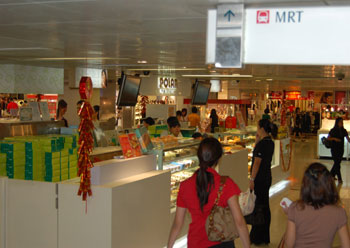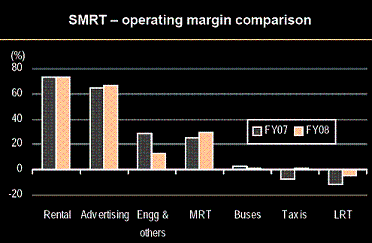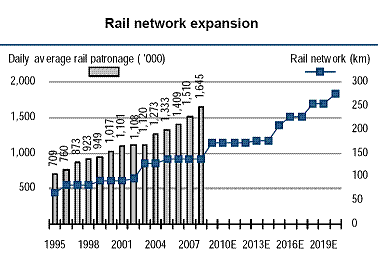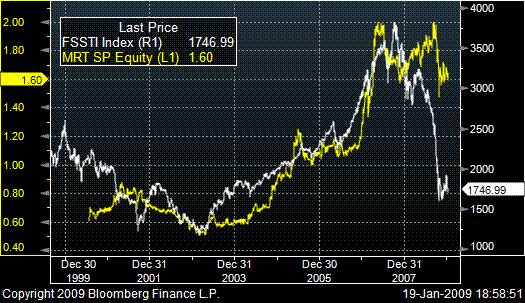
YET ANOTHER broker is positive on the land transport sector.
Echoing DMG's and Credit Suisse's sentiments, BNP Paribas, in its strategy paper released this month, views the sector as a two-time beneficiary – from government measures to encourage public transport as well as from falling oil prices.
Ahead of SMRT’s 3Q09 results that will be released this Friday after the market closes, BNP Paribas has maintained its ‘buy’ rating on the defensive play, with a target price of S$2.14.
The stock last closed at S$1.58, amounting to a 35% upside for BNP’s target.
The stock price has proven highly resilient with a historical PE of 15 times - well above the Straits Times Index’s 5.8 times.
Its dividend yield is about 5%, compared to the Straits Times Index’s 6.3%.
Close to 80% of SMRT’s revenues come from collecting passenger fares on mass rapid transit / light rail train networks and buses.
It also hires out taxis.
In addition, SMRT also provides operations and maintenance services to international train operators. Its project track record includes consultation services for the Ho Chi Minh City Rail System, Bangkok Transit System, Delhi Metro and Nanjing Metro, etc.
Hefty margins
The money-spinner, however, is from leasing of retail space at MRT stations. This segment contributes some 20% to earnings before interest and taxes (EBIT), and enjoys hefty EBIT margins of 75% compared to group margins of 23%.
Since launching its vibrant underground retail mall concept – SMRT Xchange –rental and advertising revenue CAGR have been a robust 27% and 23%, respectively, compared to 6% for group revenues over FY06 to FY08.
This began as the Raffles Xchange in 2005 – a seamless connection of retail experience for commuters walking from the MRT station to surrounding buildings such as OUB Centre, Chevron House, Hitachi Tower, Republic Plaza, UOB Plaza and 6 Battery Road.
Including Tanjong Pagar Xchange, Dhoby Ghaut Xchange and Choa Chu Kang Xchange, SMRT now owns 4 retail malls. Next in the pipeline is the Buona Vista Xchange.
As at Sep 2009, the train operator had over 300 shops on 26,592 square meters of retail space at about 30 MRT stations.
However, rental rates are expected to slide up to 30% over the next 2-3 years, according to a JP Morgan report published on 6 Jan this year.
One may also wish to note that occupancy levels of prime retail space have historically remained at above 90% throughout recessions.
$32-m earnings in Q3 expected
In the face of gloom and doom of flat results and earnings contraction by numerous companies, what’s looking up for our national MRT operator?
Firstly, government measures to increase the use of public transport and decrease car usage through measures such as increasing the number of ERP gantries are paying off.
Rail ridership in 2008 increased 11.4% yoy, compared with a 5% CAGR over the past 10 years.
Furthermore, the Land Transport Authority’s aggressive plan to double the rail network over the next 10 years to 278 km ensures steady top line growth in passenger fares as well as rental and advertising income.
Secondly, the oil price crash (by two-thirds in the past 6 months from a high of close to US$150 a barrel to less than US$50 currently) implies better margins for transport providers like SMRT and Comfort Delgro.
Broker consensus estimates SMRT to post revenues of S$219 million and net earnings of S$32 million for 3Q09.




